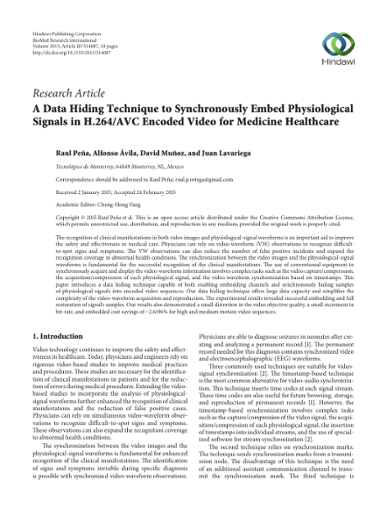Mostrar el registro sencillo del ítem
A data hiding technique to synchronously embed physiological signals in H.264/AVC encoded video for medicine healthcare
| dc.contributor.author | Peña Ortega, Raúl | |
| dc.contributor.author | Ávila Ortega, Alfonso | |
| dc.contributor.author | Lavariega Joaquin, Juan Carlos | |
| dc.creator | PEÑA ORTEGA, RAUL; 256806 | es |
| dc.creator | AVILA ORTEGA, ALFONSO; 31866 | es |
| dc.creator | LAVARIEGA JARQUIN, JUAN CARLOS; 11120 | es |
| dc.date | 2015 | |
| dc.date.accessioned | 2018-10-18T22:08:23Z | |
| dc.date.available | 2018-10-18T22:08:23Z | |
| dc.identifier.issn | 23146133 | |
| dc.identifier.doi | 10.1155/2015/514087 | |
| dc.identifier.uri | http://hdl.handle.net/11285/630570 | |
| dc.description | The recognition of clinical manifestations in both video images and physiological-signal waveforms is an important aid to improve the safety and effectiveness in medical care. Physicians can rely on video-waveform (VW) observations to recognize difficult-to-spot signs and symptoms. The VW observations can also reduce the number of false positive incidents and expand the recognition coverage to abnormal health conditions. The synchronization between the video images and the physiological-signal waveforms is fundamental for the successful recognition of the clinical manifestations. The use of conventional equipment to synchronously acquire and display the video-waveform information involves complex tasks such as the video capture/compression, the acquisition/compression of each physiological signal, and the video-waveform synchronization based on timestamps. This paper introduces a data hiding technique capable of both enabling embedding channels and synchronously hiding samples of physiological signals into encoded video sequences. Our data hiding technique offers large data capacity and simplifies the complexity of the video-waveform acquisition and reproduction. The experimental results revealed successful embedding and full restoration of signal's samples. Our results also demonstrated a small distortion in the video objective quality, a small increment in bit-rate, and embedded cost savings of -2.6196% for high and medium motion video sequences. © 2015 Raul Peña et al. | |
| dc.language | eng | |
| dc.publisher | Hindawi Publishing Corporation | |
| dc.relation | https://www.scopus.com/inward/record.uri?eid=2-s2.0-84941243039&doi=10.1155%2f2015%2f514087&partnerID=40&md5=a2144f98e5136c17c1022f511aa81d79 | |
| dc.relation | Investigadores | |
| dc.relation | Estudiantes | |
| dc.rights | info:eu-repo/semantics/openAccess | |
| dc.rights.uri | http://creativecommons.org/licenses/by-nc-nd/4.0 | |
| dc.source | BioMed Research International | |
| dc.subject | Article | |
| dc.subject | computer security | |
| dc.subject | cost control | |
| dc.subject | data hiding technique | |
| dc.subject | embedding | |
| dc.subject | human | |
| dc.subject | medical care | |
| dc.subject | medical information | |
| dc.subject | physician | |
| dc.subject | recognition | |
| dc.subject | videorecording | |
| dc.subject | health care delivery | |
| dc.subject | information processing | |
| dc.subject | medical informatics | |
| dc.subject | statistics | |
| dc.subject | trends | |
| dc.subject | Data Compression | |
| dc.subject | Delivery of Health Care | |
| dc.subject | Humans | |
| dc.subject | Medical Informatics | |
| dc.subject | Statistics as Topic | |
| dc.subject | Video Recording | |
| dc.subject.classification | 7 INGENIERÍA Y TECNOLOGÍA | |
| dc.title | A data hiding technique to synchronously embed physiological signals in H.264/AVC encoded video for medicine healthcare | |
| dc.type | Artículo | |
| dc.identifier.volume | 2015 | |
| refterms.dateFOA | 2018-10-18T22:08:23Z |
Ficheros en el ítem
Este ítem aparece en la(s) siguiente(s) colección(ones)
-
Artículo 1151
Article

